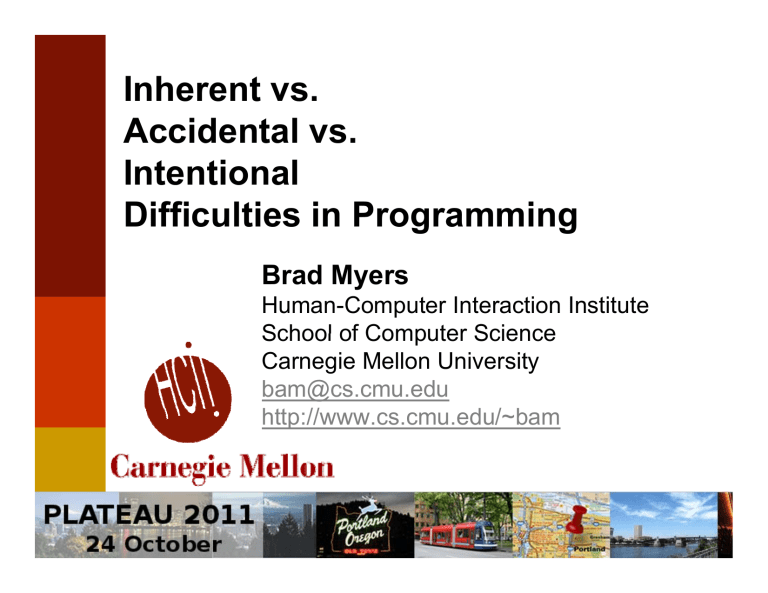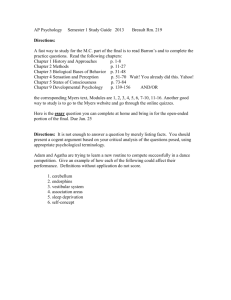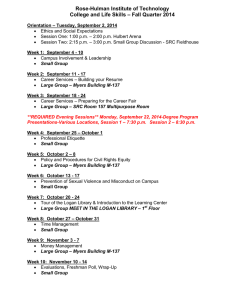Inherent vs. Accidental vs. Intentional Intentional Difficulties in
advertisement

Inherent vs.
Accidental vs.
Intentional
Difficulties in Programming
Brad Myers
Human-Computer Interaction Institute
School of Computer Science
Carnegie Mellon University
bam@cs.cmu.edu
h //
http://www.cs.cmu.edu/~bam
d / b
1
K Q
Key
Questions
ti
To what extent are the difficulties faced by
developers avoidable or fixable?
Clear that some difficulties are avoidable or fixable
Would be useful to know which ones are not
Inherent vs.
vs accidental difficulties
To what extent are the difficulties faced by
developers a result of explicit design decisions?
Intentional difficulties
© 2011 - Brad Myers, PLATEAU
2
“P
“Programming”
i ”
All the activities involved with programming
Issues with the programming language itself
Issues with libraries
libraries, frameworks,
frameworks and other APIs
Issues with tools such as IDEs
Little can be accomplished with just the language
To the developer,
developer they are indistinguishable
May
y interact with language
g g features and APIs
Professional, Novice and End-User programmers
Focus on p
programming
g
g = developing
p g = coding
g
© 2011 - Brad Myers, PLATEAU
3
“Difficulties”
Any b
A
barriers
i
to success when
h the
h d
developer
l
iis
programming
(but not those due to bad specifications)
Evaluated like other usability breakdowns
Problems with learning or remembering how to do it
Slow-downs while coding
g
Efficiency of the programming itself
Error-proneness while coding
L
Lower
quality
lit results
lt
Again, for all kinds of developers
Quality of the resulting code
Measured using various kinds of user studies
Bug reports, CIs & other field research, lab evaluations, …
© 2011 - Brad Myers, PLATEAU
4
A any Diffi
Are
Difficulties
lti “Inherent”?
“I h
t”?
“Inherent”
Inherent – “part
part of the very nature of
something, and therefore permanently
characteristic of it or necessarily involved in it”
it
-- Encarta Dictionary
Means that research on eliminating the
difficulties can never succeed
© 2011 - Brad Myers, PLATEAU
5
C
Complex
l Al
Algorithms
ith
Google search for “inherent
inherent difficulties in
programming” includes: “Researchers … have never
ceased to emphasize the inherent difficulties in solving
stochastic programming problems… Recent
developments in the theory of computational complexity
allow us to establish the theoretical complexity
p
y of most
stochastic programming models studied in the literature. Our
results confirm the general feelings alluded to above.”
-- [Dyer & Stougie,
Stougie 2003]
((Not veryy surprising)
p
g)
© 2011 - Brad Myers, PLATEAU
6
“E
“Essential
ti l complexity”
l it ”
“All reasonable solutions to a p
problem must be
complicated (and possibly confusing) because
the ‘simple’ solutions would not adequately
solve the problem”
-- Wikipedia
Complexity
p
y comes from the size and
interactions and the constraints on the parts
More interesting
g to look at difficulties with
individual aspects
And difficulties that arise from limitations of the
building blocks
© 2011 - Brad Myers, PLATEAU
7
P
Parallel
ll l Programming?
P
i ?
Google search for “inherent difficulties in
programming” includes:
“The
The ever-growing prevalence of parallel
architectures has pushed the inherent
difficulties in parallel programming to the
front stage ...” http://faspp.ac.upc.edu/
© 2011 - Brad Myers, PLATEAU
8
P
Parallel
ll l Programming?
P
i ?
But Alice claims that their approach
pp
makes it
easy
At least for simple
p situations
© 2011 - Brad Myers, PLATEAU
9
Wh t else?
What
l ?
Recursion?
How unification works in Prolog?
For some people
people, the requirement to
decompose the task into primitives is a
barrier
“Programming is the process of transforming a
mental plan into one that is compatible with the
computer.”
— Jean-Michel Hoc
© 2011 - Brad Myers, PLATEAU
10
Inherently Hard Because
C
Currently
tl Unsolved
U
l d
No one knows how to express these
Language support for distributed systems
API support for flexible user input handling
Beyond low-level event-handlers
© 2011 - Brad Myers, PLATEAU
11
A id t l Difficulties
Accidental
Diffi lti
Difficulties that can be avoided
“Accidental complexity” – “non-essential to
th problem
the
bl
tto b
be solved”
l d”
-- Wikipedia
Wiki di
“due to mistakes such as ineffective planning …”
Sh ld “b
Should
“be minimized
i i i d iin any good
d architecture,
hit t
design, and implementation”
Difficulties
complexity
Can arise from things that might be “simple”
© 2011 - Brad Myers, PLATEAU
12
Example
Difficulties in handling multiple objects
F(o) – easy to operate on one object
F(o); or o.F();
Now suppose we have a bunch of o’s
for (int i=1; i<11; i++)
{
o_array[i].F();
}
Two
Three kinds of parentheses, extra array data structure,
extra variable i
for (Otype i : o_array)
{
i.F();
}
vs. HANDS: F(o) works on either. Also: F(all o)
© 2011 - Brad Myers, PLATEAU
13
Restrictions on Built-ins
puts "Hello World" in Ruby or tcl
vs. Java
J
console
l output:
t t
public static void main(String[] args)
{
System.out.println("Hello World!");
}
9 special words and 3 types of parentheses
But how output bold, red script? Or
Compare to PowerPoint or Visual Basic
© 2011 - Brad Myers, PLATEAU
? Or sounds?
14
Unfortunate Language
g g Designs
g
Confusing keyword choices:
STOP in Logo
g – exits the current p
procedure ((doesn’t
stop the program)
static (vs. const, final) – multiple meanings
AND iin allll programming
i llanguages
Precedence
men and women
E.g., A+++B means? (A++)+ B or A + (++B)
A++++B,
, A++-+B A--+-++B
Bring home a fruit that is(not an apple)or a pear
See Java Puzzlers [[Joshua Bloch and Neal Gafter]]
“traps, pitfalls, and corner cases”
© 2011 - Brad Myers, PLATEAU
15
Source of Accidental Difficulties
Some causes:
Consistencyy with previous
p
languages
g g
Syntax in Javascript, C#, Java, … based on C (1969)
switch (month) {
case 1: …;
; break;
case 2: …; break;}
Inline conditional: d
= c ? a : b;
Constraints that are no longer relevant
Reducing amount of typing:
for(;;)
f ( ) syntax; {} instead of begin
b i end
d
Only use pure ASCII in programming languages
= and == instead of and =
No place for meta-information, history, etc.
© 2011 - Brad Myers, PLATEAU
16
Due to Programmer
St bb
Stubbornness
“Whatever
Whatever I learned first is best”
best
Resistance to learning new tools/methods/languages
“Macho”“Tools?
Macho Tools? We don
don'tt need no stinkin
stinkin' tools!
tools!”
Examples:
Auto complete is one of the most popular tools in IDEs
Auto-complete
But many people are still programming without it (e.g., in
Notepad or VI -- but VIM has completions)
Debugging is still done the same way as 60 years ago
Breakpoints, print statements, watching variables
© 2011 - Brad Myers, PLATEAU
17
Whyline
y
PhD work of Andy Ko
Allow users to directly ask “Why” and “Why not”
Collect a trace and replay trace within Whyline
Algorithm contributions
C
Complete
l t ttracing
i off Java
J
programs
Incremental, real-time
static and dynamic slicing
Slow-down, about a factor of 5
Comparable to profilers
Size 2mb/sec for interactive
programs
Causality of events
Novel UI for asking
questions
© 2011 - Brad Myers, PLATEAU
18
Whyline
y
User Studies
Initial study:
Whyline with novices outperformed experts with Eclipse
Factor of 2.5 times faster
(p < .05,, Wilcoxon rank sums test))
Formal study:
Experts
p
attempting
p g 2 difficult tasks
Whyline over 3 times as successful, in ½ of the time
© 2011 - Brad Myers, PLATEAU
19
Accidental Difficulties
D tto B
Due
Bad
d API
APIs
Inconsistent parameter orders:
Java Interface XMLStreamWriter:
writeStartElement(namespaceURI, localName)
writeStartElement(prefix, localName, namespaceURI)
Bad names, e.g. in SAP eSOA
Too long
Names which are not understandable
© 2011 - Brad Myers, PLATEAU
20
M
More
Causes
C
off Diffi
Difficulties
lti
Names that are not distinguishable
org.xml.sax.ext -> Attributes vs. Attributes2
Unnecessarily exposing underlying
mechanisms
Alpha value in Java vs. “fade”
Inappropriate models
3D transforms using matrices in radians vs.
Alice’s object-centered commands
Obj.Turn(left , 1/8), Obj.TurnTo (otherObj)
© 2011 - Brad Myers, PLATEAU
21
Object Method Placement
Where to put functions when doing object-oriented design
of APIs
mail_Server.send( mail_Message )
vs.
mail_Message.send( mail_Server )
When desired method is on the class that they start with,
users were between 2.4 and 11.2 times faster (p < 0.05)
Starting class can be predicted based on user’s
user s tasks
Time to Find a Method
20
Tim
me (min)
15
Methods on
Expected Objects
10
Methods on
p Objects
j
Helper
5
0
Email Task
Web Task
Thingies Task
22
More API Difficulties
Apparently missing functionality
Java File class has no read or write
Actual missing functionality
Select in C# .NET 1.1 [Henning, “Api Design Matters.” ACM Queue, 5(4), 2007]
Original Java APIs had to use applet class to do audio
Overwrites argument lists so requires extra copying
Does not tell if succeeds or times out
http://www.javaworld.com/javaworld/javatips/jw-javatip24.html (1997)
String
g handling
g difficulties in many
y languages
g g
E.g., Imploding and exploding arrays of strings in PHP vs. Java
Much user-centered data must be represented as strings
Ref: Chris Scaffidi
Scaffidi’s
s “Topes”
Topes
© 2011 - Brad Myers, PLATEAU
23
Accidental Difficulties
D tto B
Due
Bad
dD
Documentation
t ti
SAP eSOA documentation study
Multiple paths: unclear which one to use
Some paths were dead ends
Inconsistent look and feel
caused immediate
abandonment of paths
Hard to find required info
Brad A. Myers, CMU
24
I t ti
Intentional
l Difficulties
Diffi lti
Designer
g
made something
g difficult on p
purpose
p
Difficult by being silly
“Esoteric
Esoteric programming languages
languages” – Wikipedia
INTERCAL, from 1972
FALSE from 1992
Turing tarpit – programmed like a Turing machine with
minimal commands: ++++++++++[>+++++++>++++++++++>+++>+<<<<]>++.>+.+++++++..+++.>++.<<+++++++++++++++.>.+++.------.--------.>+.>.
Malbolge (8th circle of hell) 1998: ('&%:9]!~}|z2Vxwv-,POqponl$H
jig%eB@@>}=<M:9wv6WsU2T|nm-,jcL(I&%$#"`CB]V?Tx<uVtT`Rpo3NlF.Jh++Fdb
CBA@?]!~|4XzyTT43Qsqq(Lnmkj"Fhg${z@>
Sh k
Shakespeare
P
Programming
i L
Language
© 2011 - Brad Myers, PLATEAU
25
M
More
Seriously…
S i
l
Features made difficult because designer
does not want novices to use them
No enums in original Java because abused in C
So used final static int
No null
ll value
al e in ML
© 2011 - Brad Myers, PLATEAU
26
M
More
Difficult
Diffi lt due
d to
t a Tradeoff
T d ff
Designer
g
decides that some other requirement
q
is more important than making it easier
Or maybe
y didn’t consider developer
p difficulty
y at all
Malice vs. laziness vs. ignorance?
Classic tradeoff of high
g vs. low level control
Usually: flexibility & versatility vs. usability
Multiple steps to perform an action allows
programmer to do it in different ways
E.g., Ruby on Rails makes it easy to create websites of
specific styles, vs. Java Spring with more overhead
© 2011 - Brad Myers, PLATEAU
27
“Factory”
y Pattern
Instead of “normal” creation: Widget w = new Widget();
Objects must be created by another class:
AbstractFactory f = AbstractFactory.getDefault();
Widget w = f.createWidget();
Used throughout Java (>61) and .NET
NET (>13) and SAP
Advantages
No memory
y allocation
Indirection: easier to have other implementations
Results of lab study with expert Java programmers:
When asked
Wh
k d to
t design
d i on “bl
“blank
k paper”,
” no one designed
d i
d a ffactory
t
Time to develop using factories took 2.1 to 5.3 times longer compared
to regular constructors (20:05 v 9:31, 7:10 v 1:20)
All subjects had difficulties getting using factories in APIs
© 2011 - Brad Myers, PLATEAU
28
Control vs. Automatic
Automatic conversions of values
"1"
1 + 1 vs.
vs 1 + "1"
1 in Smalltalk vs
vs. Java
All APIs have protocols
Series of methods called in a particular order
“Boiler plate”
Example: file must be opened before read
Alternatively: read could automatically open
But more “magic”
g with objects
j
fixing
g themselves
Less control for programmer
How many protocols could be eliminated?
When would that be a good idea?
© 2011 - Brad Myers, PLATEAU
29
Cl
Classic
i Arguments
A
t
Static vs.
vs dynamic typing: more “difficult”
difficult to
enter code for more error checking
Controversy: Which makes it less difficult to get
correct code in the end?
OO vs.
vs functional
…
© 2011 - Brad Myers, PLATEAU
30
Visual Basic developers
“Make things simpler than possible. That is the
contradiction hardcore Visual Basic
programmers live with. … Our task is to
seemingly
g y simplify
p y beyond
y
the limits of the
possible; to create a sort of garden where
children play and then grow up and venture off
into the woods. The point isn’t that there aren’t
woods or that they shouldn’t see trees. The point
is that they start off in a garden
garden.”
Hide abstractions that provide flexibility wanted by
professional p
p
programmers
g
© 2011 - Brad Myers, PLATEAU
31
Goal: Gentle Slope Systems
Java
Visual Basic
Flash
Web Development
Difficulty
Diffi
lt
of
Use
What %
is accidental,
or intentional?
Low
Threshold
Swing
C Programming
C or C# Programming
JavaScript
ActionScript
CSS
Basic
Goal
High
Ceiling
If inherent, then
Program Complexity and Sophistication
maybe a low intercept,
low walls aren’t possible?
I
Implications
li ti
Usability studies & general use can identify
difficulties
D i
Designer
should
h ld d
determine
t
i if diffi
difficulties
lti are
Inherent, Accidental, or Intentional
Ed
Educate
t when
h iinherent
h
t
Fix when accidental
Document when intentional
© 2011 - Brad Myers, PLATEAU
33
Thanks!
To Andrew Faulring, Thomas LaToza, Donna
Malayeri,
y
and Jonathan Aldrich for help with this
talk
To >30 students
To funding from NSF, SAP, Microsoft, Adobe, IBM
http://www.cs.cmu.edu/~natprog
p
p g
http://ww.cs.cmu.edu/~bam
bam@cs.cmu.edu
@
© 2011 - Brad Myers, PLATEAU
34




